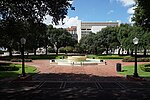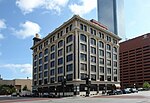Dallas Union Station
Amtrak stations in TexasAtchison, Topeka and Santa Fe Railway stationsBeaux-Arts architecture in TexasDallas Area Rapid Transit light rail stations in DallasDallas Landmarks ... and 17 more
Economy of DallasFormer Chicago, Burlington and Quincy Railroad stationsFormer Chicago, Rock Island and Pacific Railroad stationsFormer Missouri–Kansas–Texas Railroad stationsFormer Southern Pacific Railroad stationsFormer St. Louis Southwestern Railway stationsFormer St. Louis–San Francisco Railway stationsFormer Texas and Pacific Railway stationsNational Register of Historic Places in DallasRailway stations in DallasRailway stations in Dallas County, TexasRailway stations in the United States opened in 1916Railway stations on the National Register of Historic Places in TexasRecorded Texas Historic LandmarksTransit centers in the United StatesTrinity Railway Express stationsUnion stations in the United States

Dallas Union Station, officially Eddie Bernice Johnson Union Station (or simply EBJ Union Station), also known as Dallas Union Terminal, is a large intermodal railroad station in Dallas, Texas. It is the third busiest Amtrak station in Texas. It serves DART Light Rail, Trinity Railway Express commuter rail, and Amtrak intercity rail. It is located on Houston Street, between Wood and Young Streets, in the Reunion district of Downtown Dallas. The structure is a Dallas Landmark and is listed on the National Register of Historic Places.
Excerpt from the Wikipedia article Dallas Union Station (License: CC BY-SA 3.0, Authors, Images).Dallas Union Station
South Houston Street, Dallas
Geographical coordinates (GPS) Address Nearby Places Show on map
Geographical coordinates (GPS)
| Latitude | Longitude |
|---|---|
| N 32.776111111111 ° | E -96.8075 ° |
Address
Dallas Union Terminal
South Houston Street 411
75202 Dallas
Texas, United States
Open on Google Maps








